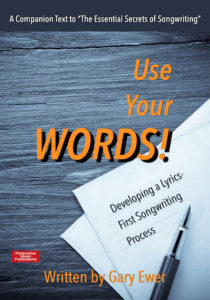It’s somewhere between possible and likely that when you come up with a song melody, you’re following pure instinct. You may work and re-work lyrics and may spend a lot of time tweaking the chords, but I wonder if melodies always seems a bit random, where the changes you might make over the course of writing a song feel somewhat arbitrary?
Fair enough: good songwriting always incorporates a good dose of experimentation, and I think that’s what makes it such an interesting pursuit. It’s exciting to feel that a song is emerging out of thin air.
 Ever try writing a song by starting with the lyric? If you find yourself feeling lost with the words-first songwriting process, read “Use Your Words! Developing a Lyrics-First Songwriting Process.” It comes FREE right now with your purchase of “The Essential Secrets of Songwriting 10-eBook Bundle.
Ever try writing a song by starting with the lyric? If you find yourself feeling lost with the words-first songwriting process, read “Use Your Words! Developing a Lyrics-First Songwriting Process.” It comes FREE right now with your purchase of “The Essential Secrets of Songwriting 10-eBook Bundle.
But it’s also fair enough to remind you that there are things you might consider that will help you create melodies that are enticing and attractive. For instance:
- Try thinking of melodies as a first step in your process, and then think of chords that might go with them. If your instincts always lead you to develop the chords first, you might be surprised that imagining snippets of melody first will usually be easier than you think.
- Spend time saying your lyric, and find the rhythms that bring it alive. Then use those rhythms in the construction of your melodies.
- Don’t be afraid to write melodies that are constricted in range, using only a few different pitches. You can set up melodic patterns that are easy to sing and easy for listeners to remember.
Regarding that 3rd point, give the song “SGL” (Now, Now) a good listen, and you’ll love the minimalist feel that a restricted-range melody can give:
It’s amazing how much mileage they get with the short 3-note cell — C#-B-A in the key of A major — which then morphs into something slightly different for the second half of that verse. That second half actually operates as a pretty respectable chorus, even though it’s simply playing around with the same 3 notes in a different order.
When they finally reach what sounds like a proper chorus, (“Starry-eyed…”), the range is wider, the high notes higher, but still everything is done with a measure of subtlety and care. I think what I love so much about the construction of this great song is how carefully the form is spun. The lines between sections are deliberately blurred.
What jumps out to me with this song is the power of subtlety. The highest note in the “Starry-eyed” chorus is only an A — a minor 3rd above what the verse offered earlier.
If you’ve been developing a great lyric, and you want people to focus on it as a major part of your song’s offerings, try deliberately minimizing the range of the melodic ideas you construct. As long as those melodic ideas are catchy and rhythmically locked-in to your song’s groove, you’ll find that purposely restricting the range has the beneficial effect of causing your audience to move their focus elsewhere — likely toward a good lyric.
 Written by Gary Ewer. Follow Gary on Twitter.
Written by Gary Ewer. Follow Gary on Twitter.
Thousands of songwriters are using The Essential Secrets of Songwriting eBooks to straighten out their songwriting problems. Have you been spending years just reinforcing errors? Sort out your technique! Get today’s free deal!











